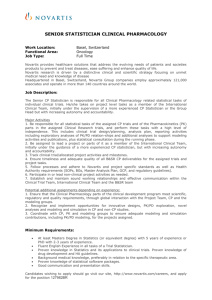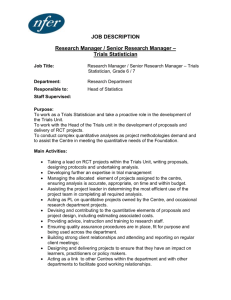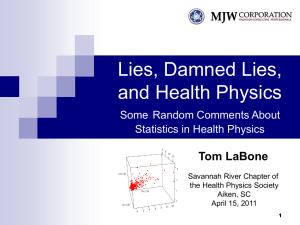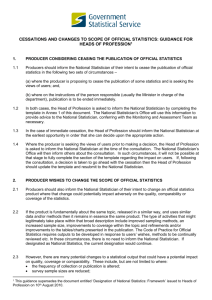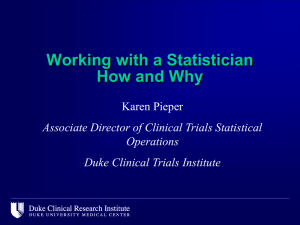UoB-CLN-STA-SOP-001 Statistics in Clinical Trials v1.0 for
advertisement
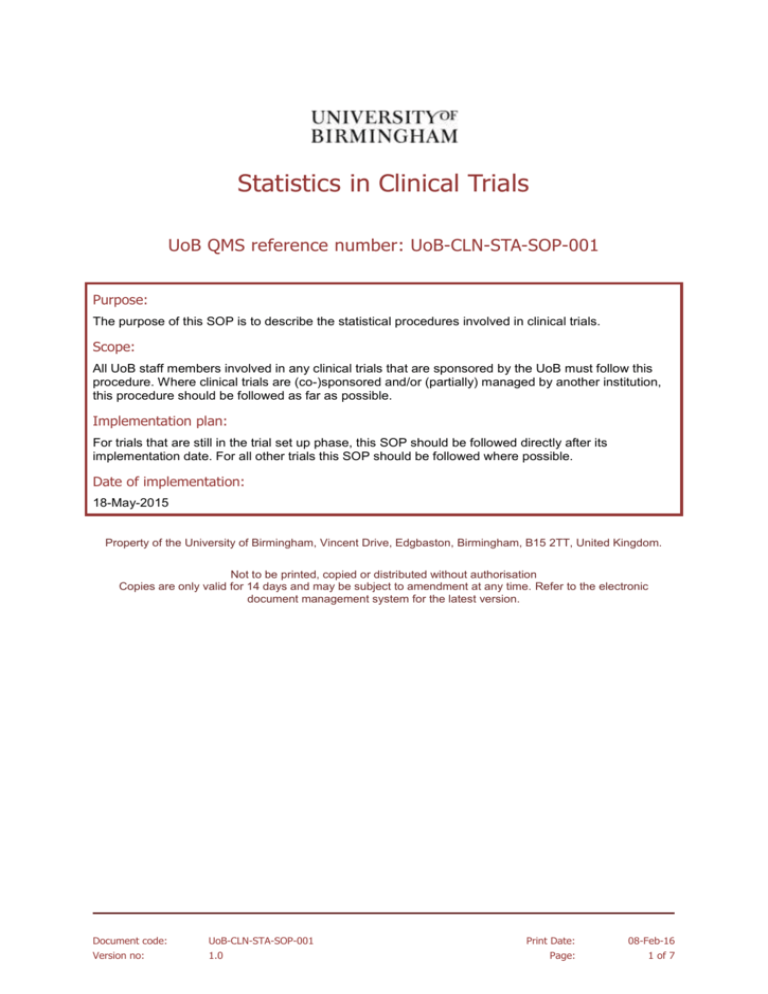
Statistics in Clinical Trials UoB QMS reference number: UoB-CLN-STA-SOP-001 Purpose: The purpose of this SOP is to describe the statistical procedures involved in clinical trials. Scope: All UoB staff members involved in any clinical trials that are sponsored by the UoB must follow this procedure. Where clinical trials are (co-)sponsored and/or (partially) managed by another institution, this procedure should be followed as far as possible. Implementation plan: For trials that are still in the trial set up phase, this SOP should be followed directly after its implementation date. For all other trials this SOP should be followed where possible. Date of implementation: 18-May-2015 Property of the University of Birmingham, Vincent Drive, Edgbaston, Birmingham, B15 2TT, United Kingdom. Not to be printed, copied or distributed without authorisation Copies are only valid for 14 days and may be subject to amendment at any time. Refer to the electronic document management system for the latest version. Document code: UoB-CLN-STA-SOP-001 Version no: 1.0 Print Date: 08-Feb-16 Page: 1 of 7 Statistics in Clinical Trials Abbreviations and Definitions: Term Description Blinding Blinding is the process that keeps one or more parties involved in a trial (for example, the sponsor, the investigator team, and/or the subject) unaware of what treatment arm subjects have been randomised to. In relation to an Investigational Medicinal Product, blinding is the deliberate disguising of the identity of the product in accordance with the instructions of the sponsor. Case Report Form (CRF) A printed, optical or electronic document designed to record all of the protocol required information to be reported to the sponsor on each trial subject. Data snapshot (also A copy of a dataset as it exists at one particular point in time known as frozen dataset) Hard-coding Programming term, whereby a variable’s value (i.e. a data point) in the dataset is changed directly within the database tables (e.g. by using an ‘ifthen’ function). Outcome measure(s) The specific measure(s) used to assess whether the trial objectives have been met. Randomisation The process of assigning trial subjects to treatment or control groups in order to reduce bias. Statistical Analysis Pre-specified statistical methodology documented for the trial, either in the protocol or in a separate document. Plan Trial team Chief Investigator (CI) and their team of individuals taking on CI duties relating to the trial management. Individuals may include co-investigator, Trial Coordinator, Trial Administrator and/or Data Manager. Trial statistician A qualified statistician who contributes to the design, analysis and interpretation throughout the trial life cycle and takes responsibility for the statistical aspects of the trial. The trial statistician may be unblinded to the trial allocation and evolving results whilst performing interim analyses, but will not disclose these to the rest of the trial team. There may be a senior statistician supervising a more junior statistician. Statistical advisor A qualified statistician or experienced trialist who may contribute to some, but not all, aspects of the trial design and analysis, but takes responsibility for the statistical aspects of the tasks they perform. Background: Statistics is a fundamental component of clinical trials. The trial design and analysis of the resultant data must be scientifically sound in order to ensure that the results are meaningful, free from bias, and answer the research question. Inclusion of an appropriately qualified statistician in the trial team is essential for many trials. In some simple studies (e.g. early pilot studies) where analysis is descriptive the use of a qualified statistician may not be required; this should be justified in the sponsor’s risk assessment. For trials where the University of Birmingham (UoB) takes on the sponsor responsibility for trial risk assessment, this risk assessment will be delegated to the Chief Investigator (CI). Document code: UoB-CLN-STA-SOP-001 Version no: 1.0 Print Date: 08-Feb-16 Page: 2 of 7 Statistics in Clinical Trials For trials which may change prescribing practice or standard of care an appropriately qualified and experienced statistician should take responsibility for the statistical methods, including but not limited to the design of the trial; creation of the Statistical Analysis Plan (SAP); performance of interim analyses and the final analyses; interpretation of the results and contribution to the publication(s). Responsibilities: Sponsor (for UoB via the Research Governance Team): Ensure that there is an appropriate level of statistical input into each trial run by independent investigators as part of the sponsor sign-off process prior to submission for ethical opinion and regulatory approval, by ensuring that there is a named qualified statistician and that they have agreed to take on the role of trial statistician. Chief Investigator: Ensure advice is sought from appropriate statistics personnel and that evidence of their suitability is filed in the TMF. Where a statistical advisor is used, ensure that responsibilities of the statistical advisor are set out in a memorandum of understanding or collaboration agreement. Ensure that the risk assessment captures the level of trial statistician/statistical advisor involvement and the justification for this. Ensure that an appropriate level of trial statistician/statistical advisor involvement is sought regarding the trial/protocol design, Case Report Form (CRF) design, and data management activities, implement this advice as appropriate, and retain evidence of this involvement. Ensure that protocol amendments that are likely to have an impact on the design and analysis of the trial are reviewed by a trial statistician/statistical advisor (as appropriate as per the risk assessment), that evidence of this review is retained, and that the Statistical Analysis Plan is updated as required. Ensure randomisation and blinding are addressed appropriately, see UoB-CLN-CTM-SOP002, Randomisation and Blinding for further information Ensure that the pre-specified statistical methodology to be used for analysis of the trial data is documented as a statistical analysis plan (SAP) after the protocol has been finalised and updated as a consequence of amendments, throughout the trial Ensure that the trial statistician/statistical advisor approves each version of the statistical analysis plan and that documentation of this approval is retained. Set up a process to ensure the capture of any protocol deviations that have an impact on analysis Ensure that all protocol non-compliances are documented and collated prior to analysis Ensure that statistical programming and analysis is carried out appropriately, and that reports and publications are prepared as required. Ensure that adequate documentation is retained to allow verification that data have been accurately handled and reported in accordance with the principles of GCP. Ensure that documentation related to statistical processes is archived with the rest of the TMF at the end of the trial. Note: The CI may delegate specific tasks. It is strongly recommended to have delegation of tasks documented, e.g. via job descriptions of trial team members, a trial delegation log and/or in Clinical Trials Units via SOPs. The CI remains responsible and their input should be clearly visible throughout the duration of the trial. Procedure: 1. Identify statistical support Appropriate advice on trial design and statistical methodology must be sought at the initial conceptualisation of a trial. The level of ongoing input required from a qualified statistician should be justified within the risk assessment (see next section for further detail). The CI must be able to demonstrate that the trial statistician/ statistical advisor possess relevant statistical qualifications and experience. Document code: UoB-CLN-STA-SOP-001 Version no: 1.0 Print Date: 08-Feb-16 Page: 3 of 7 Statistics in Clinical Trials A signed and dated CV, listing statistical/ methodological training and professional society memberships, must be collected from the trial statistician/ statistical advisor and filed (e.g.) in the Trial Master File (TMF) Where the statistical advisor is not, or will not be, a member of the trial team or CTU, responsibilities must be set out in a memorandum of understanding (internal advisor within UoB, e.g. CTU statistician advising an independent Investigator) or collaboration agreement (external advisor, e.g. statistician from another organisation) Where at all possible, include appropriate funding for statistical support in grant applications and name statistical advisor as a co-investigator 2. Trial design and protocol development Seek appropriate statistical advice for the trial as early as possible in the trial design process (before protocol development, wherever possible) Seek advice on the following aspects of the trial: o Trial design (e.g. phase, adaptive, inclusion of a feasibility/pilot) o Formulating trial objectives o Suitability of outcome measures for meeting the objectives of the trial o Methods to reduce bias o Sample size o Randomisation: o Stratification variables o Blinding o Statistical stopping guidelines (e.g. futility, superiority) o Analysis methods (final and interim) Retain evidence of trial statistician/statistical advisor involvement in trial/protocol design as applicable (e.g. emails, meeting minutes, comments on proposals/ protocols) Document within the risk assessment the level of input required from a qualified statistician for the remainder of the trial, and the justification for this: o For example, where only simple summary statistics are required, the Chief Investigator may have sufficient knowledge and experience o Typically, trials will require continued involvement from a qualified statistician, including trial design, CRF development, database design, input into the data management process, and analysis. 3. Case Report Form design and data management activities Where appropriate (as per the risk assessment), seek advice from a qualified statistician when developing the CRF and the trial database, and retain evidence of statistician involvement (e.g. emails, meeting minutes) Where appropriate (as per the risk assessment), seek advice from a qualified statistician regarding data management for the trial, and retain evidence of statistician involvement in data management (e.g. review/approval documentation) Set up a process to ensure the capture of any protocol deviations that have an impact on analysis. Ensure that all protocol non-compliances are documented and collated prior to analysis 4. Randomisation and blinding Set up randomisation and blinding processes if appropriate for the trial; for details on randomisation and blinding processes see UoB-CLN-CTM-SOP-002, Randomisation and Blinding. 5. Amendments Ensure that protocol amendments that are likely to have an impact on the design and analysis of the trial are reviewed by a trial statistician/statistical advisor (as appropriate as per the risk assessment) Document code: UoB-CLN-STA-SOP-001 Version no: 1.0 Print Date: 08-Feb-16 Page: 4 of 7 Statistics in Clinical Trials o o o Review the impact of the amendment on CRFs and trial systems Review the impact of the amendment on Statistical Analysis Plan Retain evidence of this process (e.g. emails, meeting minutes) 6. Statistical analysis plan Document the statistical analysis plan (SAP) in the protocol or in a separate document, after the protocol has been finalised and before any analysis is undertaken. As a minimum, the statistical analysis plan should include for the primary outcome: How the outcome will be measured Appropriate statistical tests which will be used to analyse the data Where appropriate, the SAP should include details on these, and other, analytical aspects: o Handling missing data o Adjustments for multiple testing or multiple comparisons o Pre-specified sub-groups o Rules for calculation of derived variables o Use of baseline and co-variate data o Levels of confidence/ statistical significance o Sensitivity analyses o Treatment interactions, particularly for subgroup analyses, cross-over or factorial trials Update the SAP as a consequence of amendments, throughout the trial, ensuring that consistency with the protocol is maintained and that appropriate version control is employed and changes justified. Ensure that the trial statistician/statistical advisor (where one is involved in the trial) approves (each version of) the SAP and that documentation of this approval is retained (e.g. emails, meeting minutes) 7. Statistical programming, analysis and publication Consider performing electronic or batch data clarification checks for data cleaning, see UoBCLN-DMA-SOP-001 Data Management for further information. Prepare for a frozen copy (snapshot) of the dataset to be made for analyses; ensure the frozen dataset is preserved so it may be reproduced if required at a later date All macros and programs used during the analysis should be validated Do not use hard-coding during the analysis process Perform checks to ensure that the output of the statistical analysis process is accurate Where appropriate, perform interim analyses at the intervals specified in the trial protocol (e.g. for Data Monitoring Committee (DMC) meetings) and following the Statistical Analysis Plan o Where a decision is taken to cancel interim analysis (e.g. due to insufficient subject numbers), document this o If the trial is blinded, and interim unblinded analysis is required, ensure the trial team cannot gain access to unblinded data or the randomisation schedule Include an appropriate audit trail in the statistical analysis process, in order to allow the data analysis to be reconstructed from start to finish. o An appropriate audit trail means that the final trial results for publication/reports can be traced back to the statistical program output and the datasets used. For example, a table of results including a t-test and 95% confidence interval should be verifiable against information that shows who undertook the analysis, and how and when this analysis occurred. o Records and computer files must be maintained to allow the flow of data to be confirmed from the extracted datasets to any subsequently created variables/datasets used in the analysis. o Audit trail documentation must enable reconstruction of events to allow assessment of the sequence in which they occurred. Document code: UoB-CLN-STA-SOP-001 Version no: 1.0 Print Date: 08-Feb-16 Page: 5 of 7 Statistics in Clinical Trials o Apply appropriate version control to all outputs of the statistical process. Prepare the analytical section of trial reports (e.g. DMC, end of trial report, reports to other third parties e.g. ethics, funder etc) Present interim analyses to the DMC, where applicable For publications of randomised trials, the CONSORT (Consolidated Standards of Reporting Trials) statement guidelines should be followed (see references) Ensure that the trial statistician/statistical advisor (where one is involved in the trial analysis) reviews publications prior to submission. It is appropriate for a trial statistician to be an author on the publication. 8. Essential documentation and archiving Adequate documentation must be retained to allow verification that data has been accurately handled and reported in accordance with the principles of GCP. This includes (but is not limited to): o Statistical Analysis Plan (where separate from the protocol) o Audit trail documentation (see previous section for details) Ensure that documentation related to statistical processes is archived with the rest of the TMF at the end of the trial Related documents: UoB-CLN-CTM-SOP-001: Clinical Trial Management UoB-CLN-CTM-SOP-002: Randomisation and Unblinding UoB-CLN-DMA-SOP-001: Data Management UoB-CLN-TQM-SOP-001: Trial Quality Management References: Medicines and Healthcare products Regulatory Agency (MHRA). Good Clinical Practice Guide, London: The Stationery Office, 2012. CONSORT (Consolidated Standards of Reporting Trials) statement guidelines (http://www.consort-statement.org/) guidelines. Acknowledgements: The first version of this procedure was developed with reference to the Cancer Research UK Clinical Trials Unit Statistical Procedures SOP and quality control documents. We would like to thank all staff members within the CTUs who have been involved in developing these SOPs for their time and efforts. Document code: UoB-CLN-STA-SOP-001 Version no: 1.0 Print Date: 08-Feb-16 Page: 6 of 7 Statistics in Clinical Trials Development summary: Author: Name: Cara Lax-Williams Function: CRCTU Quality Assurance Officer Date: See original copy Reviewed by: Sarah Bowden, CRCTU Director of Operations Prof. Keith Wheatley, CRCTU Scientific Director Isobel Hawley, CRCTU QA Manager (maternity cover) Jane Daniels, BCTU Deputy Director Natalie Ives, BCTU Senior Statistician Razia Meer-Baloch, PC-CRTU QA Manager Clinical Trials Oversight Committee Signature: See original copy Authorised by: Name: Prof. Julian Bion Function: Chair of Clinical Trials Oversight Committee Date: See original copy Name: Wilma van Riel Function: Clinical Trials Quality Assurance Manager Date: See original copy Issue date: 27-Apr-2015 Supersedes: N/A Signature: See original copy Signature: See original copy Reason for update: N/A Review of final version: Date: Reviewed by: Signature: Outcome: N/A Document code: UoB-CLN-STA-SOP-001 Version no: 1.0 Print Date: 08-Feb-16 Page: 7 of 7
